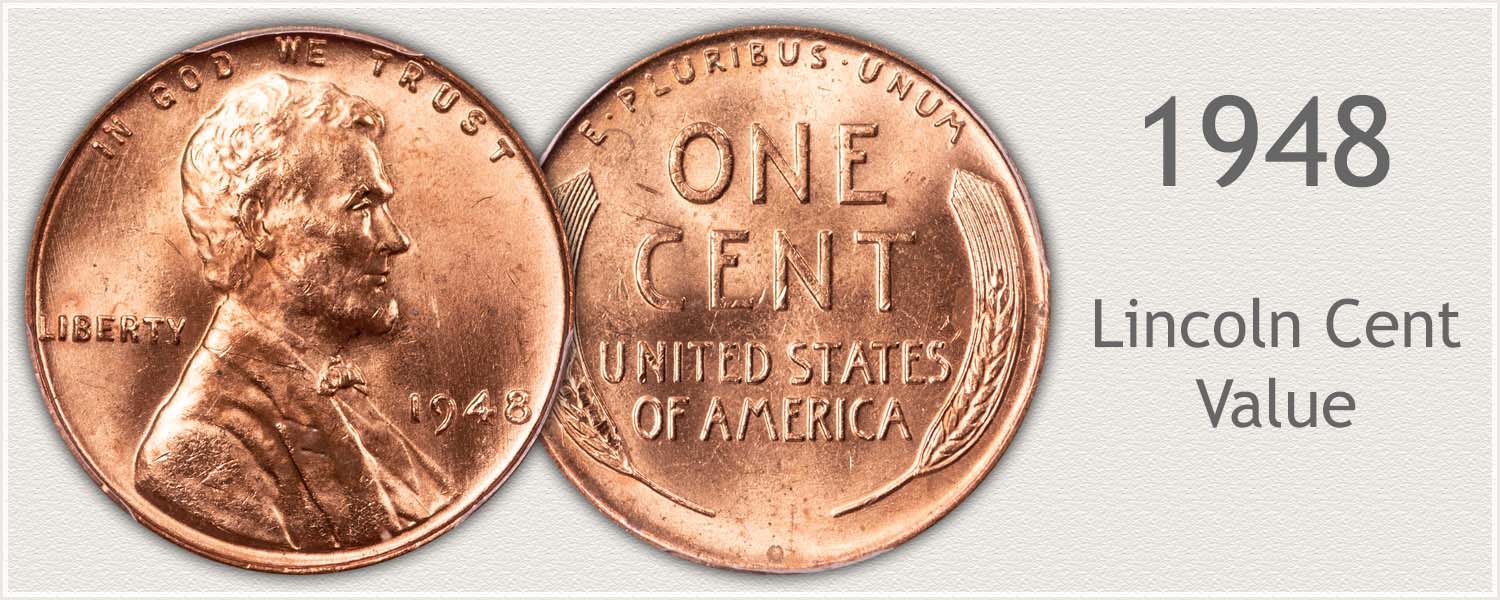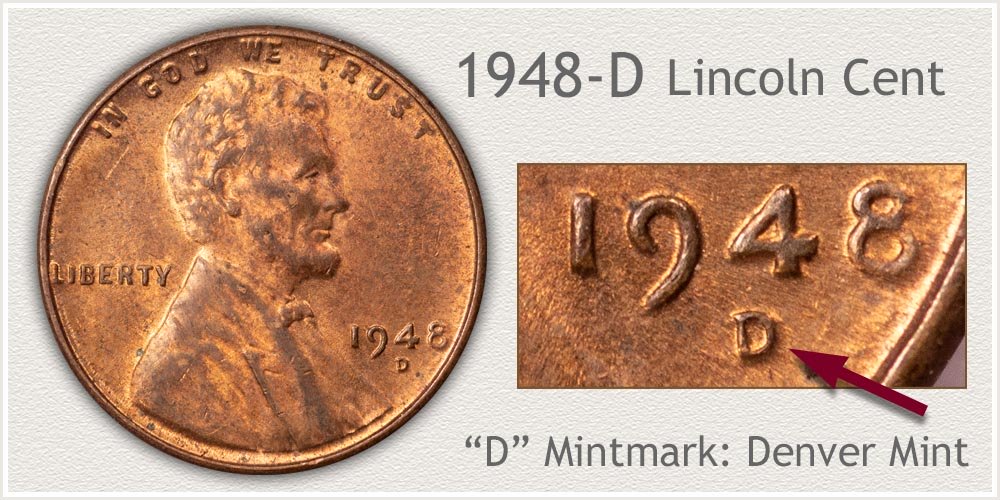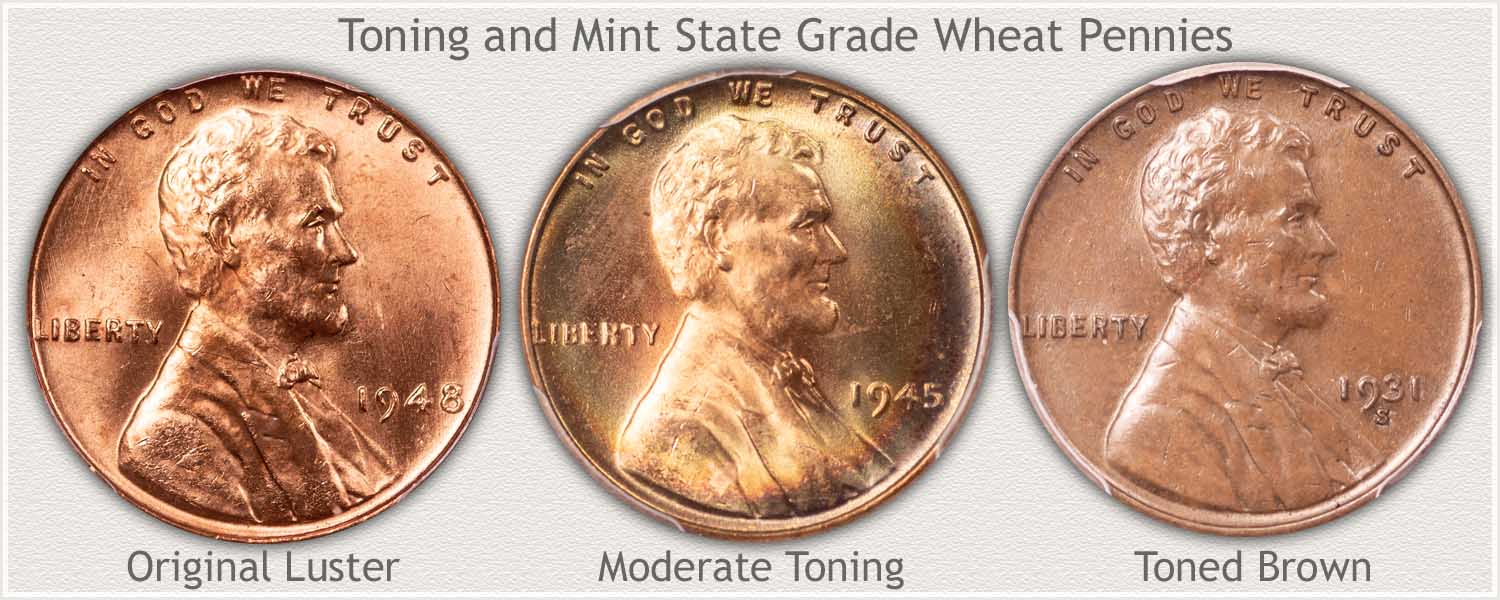Coin Values Moving with Precious Metals: Up-Dated 12/8/2025: Gold $4212 | Silver $58.12
1948 Penny Value
Popularity and interest of collectors determine 1948 penny value. A focus is placed on assembling a collection in high grade. Premium condition coins are needed and premium values are attached to these coins.
First step is inspecting to confirm Date | Mint Mark. Judging how much a 1948 cent is worth begins here. Different mints produced important varieties.
Continue by inspecting condition. Compare to images of the different grades finding a close match, narrowing the range on the chart.

Steps Leading to Value:
- Step 1: Date and Mintmark Variety – Identify each date and its mintmark variety.
- Step 2: Grading Condition – Judge condition to determine grade.
- Step 3: Special Qualities – Certain elements either enhance or detract from value.
| 1948 Lincoln Penny Value | ||||
|---|---|---|---|---|
| Condition of Coin | ||||
| Date | Good | Fine | Extremely Fine | Uncirculated |
| 1948 Lincoln Penny Value Up-Dated | 2025 | |||
| 1948 | $0.02 | $0.02 | $0.03 | $2.02 |
| 1948 D | $0.02 | $0.02 | $0.03 | $2.52 |
| 1948 S | $0.02 | $0.03 | $0.04 | $3.70 |
Listed by date and mint mark variety the chart further narrows value by the condition of the coin. Grades of Good, Fine, Extremely Fine, and Uncirculated are described in the Grading Section below.
Step one is identify and confirm the mint that struck your coin. Use the images to locate any possible mint mark.
A second important step is condition. Give special attention to judging condition. Many of these wheat cents are in low average condition. Reading the value chart shows the increase in desirability of higher condition coins. In the Grading Section images are used to match your coin. Inspecting for wear and subtle points to condition are described.
Step 1: | Date and Mintmark Combination
1948 Variety Identification
A small premium is listed for San Francisco variety 1947 wheat cents. Collector interest, a basis to value, is directed to each variety and its state of preservation. Boldness of detail, evenness of toing - color of surfaces - and no noticeable marks are desirable traits.
1948 Lincoln Penny
No Mintmark Under Date: Philadelphia Mint Struck the Coin

Ample supplies of wheat cents existed at the time requiring Philadelphia to only mint 217,775,000 cents in 1947. These are Abundant today on a rarity scale.
Above average quality is what obtains a strong value in the market. Desirable are well preserved coins void of excessive nicks and discoloration. Circulated 1947 pennies are separated into main groups of lightly worn examples and any of lesser quality. Clear lines in Lincoln's coat from shirt is needed to obtain above average status.
1948-D Lincoln Penny
"D" Mintmark Under Date: Denver Mint Struck the Coin

Available in high numbers; rarity is Abundant on the scale. Many of these coins are gathered, assembled into rolls of 50 coins, and marketed in that form. Higher condition examples - lightly worn pieces are often separated and included in circulated sets. Creating an affordable set of 1941-1958 cents as an entry to the hobby.
Examine any 1948-D penny, noticing full parallel lines at ends of wheat stalks indicates a higher end example. A potential beginning to coin collecting.
1948-S Lincoln Penny
"S" Mintmark Under Date: San Francisco Mint Struck the Coin

The allure of San Francisco cents is noted by a slight premium on the chart. Throughout the wheat series, San Francisco historically produced the fewest numbers, creating a lower supply variety. A pattern continued in 1948 striking 64,290,000 wheat pennies.
Saving freshly minted coins and quantities from circulation at the time saved enough to place these overall as Abundant on the rarity scale. Lightly circulated coins, grading Extremely Fine or better are worth a closer inspection. Details within Lincoln's hair are examined for flatness.
Step 2: | Judge Condition to Identify Grade
1948 Lincoln Penny Value is Conditional
Grading a coin involves judging condition of the devices, legend, and fields against a standard for the grade. Images are compared to your coin helping visualize differences in amount of wear the surface.
Achieving an accurate value involves an accurate determination of grade. When viewing your coin, first overall impression is important. An above average coin is crisp in all details. Lincoln's bust shows the majority of original design.

Uncirculated Grade: Bright luster shines from the mint state - uncirculated 1948 penny. Importantly there is no evidence of wear on the surface. The coin never entered circulation and all parts of the design are intact.
High in profile and prone to wear is the cheek line just under Lincoln's eye. A rounded contour remains with complete coverage of luster and fine texture. A close look confirms no smoothing or color change.
A few marks are found on the cheek and jaw line, contact from other coins. Marks and abrasions are the norm. The few marks noticed are not heavy or large, the fields are remarkably free of abrasions.

Uncirculated Grade and Toning 1948 Penny One feature having an impact on value in the mint state grade is color and toning of the surface. The 1948 penny with original luster is untoned. The moderate toning on the center coin is beginning around the rims and is pleasing in the various shades of brown. To the far right is a completely toned brown wheat penny.
All examples are mint state, no wear to the surface. Separating these in value is the appeal of color and toning. An uncirculated wheat penny toned brown is pleasing, however many collectors prefer luster with shades of original color. Moderate toning is found on many mint state coins, now eye appeal and shades of color becomes important. An elusive bright original cent with no toning has received special care and is sought by collectors.

Extremely Fine Grade: Once entering circulation wear to the surface of a coin begins immediately. First to notice is luster on the highest areas of smoothness replacing the fine texture. Small flat areas soon begin to develop as wear removes metal. Light wear defines the extremely fine grade.
Lincoln's cheek is a high relief area. Just below his eye and moving towards his ear is a rounded area prone to signs of wear. A line of smoothness and flattening is evident on the example. Only light wear has developed and a distinct separation of ear and cheek remains.
Overall wear to the hair, jaw, and coat is minor. A soft brown color highlights the remaining bold detail. Full separation is seen within hair waves, cheek and jaw lines are separate, and coat lapel is distinct.

Average Circulated Condition: As wear removes moderate to heavy amounts of detail from a wheat cent; wide areas of flatness remain. These coins fall below the Extremely Fine grade and are abundant.
Wear has lowered the profile of the cheek line and it now connects with the ear. A wide flat jaw line is also typical of an average condition wheat penny. Notice the areas of wear on Lincoln's coat and how the flatness extends from his collar along the shirt line to rim.
A majority of cents from the 1940's are available in average circulated condition and form the base value to wheat cents.
Video | Grading Lincoln Wheat Pennies
Additional insight into value and judging condition is covered by visiting Grading Lincoln Wheat Pennies. Many later date wheat cents post 1943, are separated in value by easily recognizable differences in condition. Early dates, pre 1944 are higher in value and need closer inspection.
Step 3: | Special Qualities Enhancing Value
Wheat Cent with Missing Lettering
Minting a quality wheat cent requires precise creation of the dies and precision during the striking phase. Small variances in the process show on the final wheat penny. Imaged is a wheat cent displaying areas of weakness to the design and missing letters.

To the left of Lincoln, "Liberty" is missing the letters "IB" completely with a partial "L" just visible. "IN" of In God We Trust only shows the upper parts of the letters. Lincoln's shoulder near the rim is completely flat, no coat details.
On the reverse is a dramatic missing of the "O" in "One Cent". "E Pluribus Unum" along the upper rim is also missing many of the lettering.
Although the example is worn, the amount of wear is not enough to account for complete lacking of design in areas and missing letters. Wear is typically uniform, problems on this coin are localized. Weakness on the obverse is in the area of Lincoln's shoulder, a high relief area. The "O" in ONE on the reverse is in the same position opposite the shoulder. Notice the weakness of "AM" part of America. Another area opposite the high relief area of Lincoln's portrait.
A slight variation in the strike spacing of top and bottom dies did not completely impress the design into the coin.
Two factors limit potential added value to this coin. Producing coins with weakly struck areas happened to frequently throughout the series. Secondly, appeal of the coin is to a smaller group of collectors, limiting its demand and premium value. A greater number of collectors seek a nice date and mintmark example and prefer a fully struck coin.
ReferencesUS Mint. 1949 US Mint Annual Report https://nnp.wustl.edu/library/publisherdetail/51
Coin Values | CoinStudy Articles
Lincoln Wheat cents span the years 1909 through 1958. From the top condition coins collected by advanced collectors to worn examples; to an affordable collection for young collectors, the range of value is extensive. Identify your date, mint and condition and refer to the value chart.
Coin Value Guide | How to Value a Coin Collection
A step by step method combined with the coin value online guide identifies how to value a coin collection. Discover how much your box of old coins is worth.
★ Coin Values Discovery finds 1948 Penny Value and...
All US coin values. Recognize your old coins using the image links leading to value charts. Date | Mintmark | Condition are considered; all described and imaged within each series. Surprising value is often found in the smallest of detail.